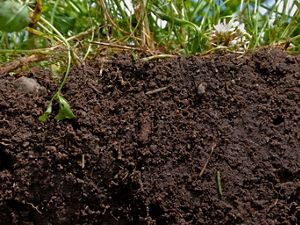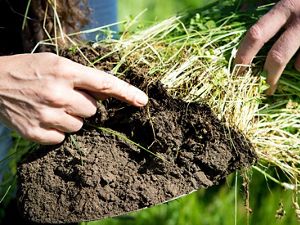In the Dirt Beneath Our Feet
Climate Solutions for Latin American Agriculture
By Ginya Truitt Nakata, Former Director of Lands, Latin America
Soil has long had a PR problem. Societies are conditioned to react negatively to anything that is “soiled” – from carpets to linens to diapers, not to mention a person’s reputation. To many of those who do not work the land, soil is dirt. And dirt is bad, right?
Actually, no, soil is good, very good—for all of us and its beauty and usefulness go well beyond its importance to agricultural productivity. Soil’s inherent value touches every single human being on the planet, even those who live far from farms and fields. Everyone has to eat, we all need nutritious food to stay healthy, and we are all impacted by the changing climate. Soil plays a fundamental role in all of these.
Fortunately, there is a growing movement in agriculture to recognize that the tiny organisms such as those you might find on your kitchen sponge are pretty much what keep soil productive year after year. Healthy soil has more than a billion microbes per teaspoon, and these are what facilitate hardy and nutrient-rich plant life. To thrive, these little guys need plenty of carbon added to and retained in the soil. This is why some farmers are now turning away from applying synthetic, inorganic fertilizers and carbon-depleting practices such as tilling the soil and turning toward regenerative practices such as the use of nutrient-rich manure or compost and no-till farming. And they are doing it because preserving the resilience and health of their soil is enabling them to become more productive and profitable.
But there is an important by-product of this. Inasmuch as keeping carbon in the soil means that it is not being released into the atmosphere (which, as we all know, is already overloaded with carbon), climate scientists are now looking at the potential of the world’s croplands as a repository for the carbon that has been fouling our air and our oceans. The aim would be to prevent the further release of carbon that is locked in the soil while expanding the use of regenerative farming practices to grab more carbon out of the atmosphere and put it back in the ground where it belongs.
A study published recently in Scientific Reports and conducted by an international group of scientists from the Chinese Academy of Science, The Nature Conservancy (TNC), and International Center for Tropical Agriculture (CIAT) says that increasing soil carbon in croplands through improved soil management could contribute to annual carbon emissions reductions of up to 1.85 billion tons per year, equivalent to removing up to 400 million cars from the roads.
While the report identifies farmlands in North America and other Northern Hemisphere regions as having the greatest potential for storing more carbon in the soil, Latin America could reduce carbon emissions by nearly 200 million tons annually through soil carbon sequestration, with about two-thirds of that coming from Brazil and Mexico. While this is impressive, there is so much more that Latin America can gain from a greater focus on soil as an important carbon sink. It would yield much more in benefits—for the climate, for biodiversity, for important natural habitats, and for agriculture itself.
For example, collaborative land use planning involving governments, scientists, and farming communities—and aimed at preserving existing carbon stocks while improving soil resiliency on land already in use—will go a long way toward reducing the conversion of natural habitats to agriculture, which is the continent’s biggest source of greenhouse gases.
Moreover, soil restoration and restocking carbon is important for increasing agricultural yields, and enabling farmers and ranchers (particularly small and medium-size operations) to become more sustainable and profitable. Putting more organic carbon into the soil has benefits for almost any farming system, as well as for invigorating the biodiversity that supports nutritious food and human health.
This will require a further shift away from longstanding, carbon-depleting practices such as tillage, crop residue removal, mono-cropping, excessive grazing, and blanket use of chemical fertilizers and pesticides and toward practices such as planting cover crops to prevent erosion and to capture more carbon and nitrogen from the atmosphere. In livestock, we need to focus especially on emerging practices to reduce, for instance, how much methane cattle are releasing into the atmosphere while upgrading their role in naturally fertilizing soil and cycling nutrients.
The Nature Conservancy has been involved in a number of projects that are encouraging this transformation and, by doing so, helping farmers get more out of the land they are already using instead of having to constantly expand into natural habitats.
If Latin American agriculture can continue along this path, and if it really focuses on not only locking carbon into the soil but in restoring and regenerating the soil’s organic fitness and quality, we will create far-reaching benefits that go well beyond addressing the climate change challenge. With a focus on soil, agriculture can be a pro-climate activity. It can be a highly sustainable, more productive, and more profitable one as well. The nutrient-value of food will improve, thereby helping address a key element of maintaining global food security. And it will do wonders for the quality of our water and our air. Truly a win-win for everyone.
So, let’s get down and dirty and rejoice in the potential of our soils to restore and renew—and to assure a more sustainable and healthful future for humanity.
Originally posted on Chicago Council on Global Affairs on January 17, 2018.



